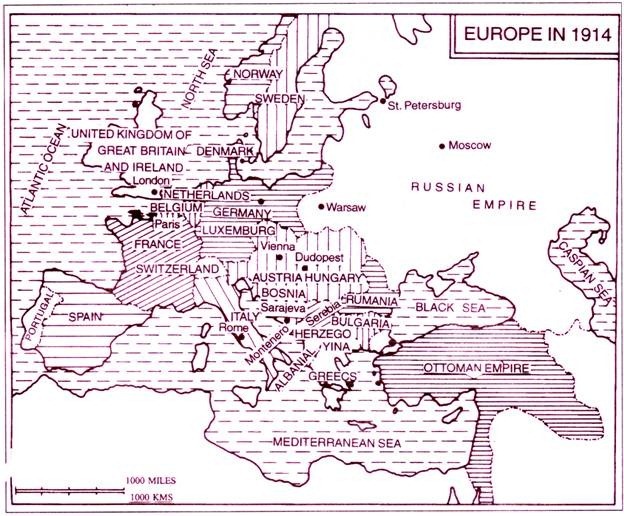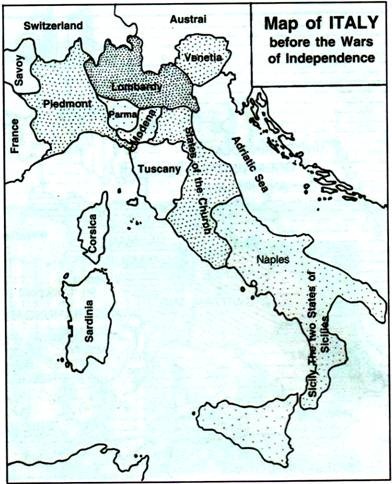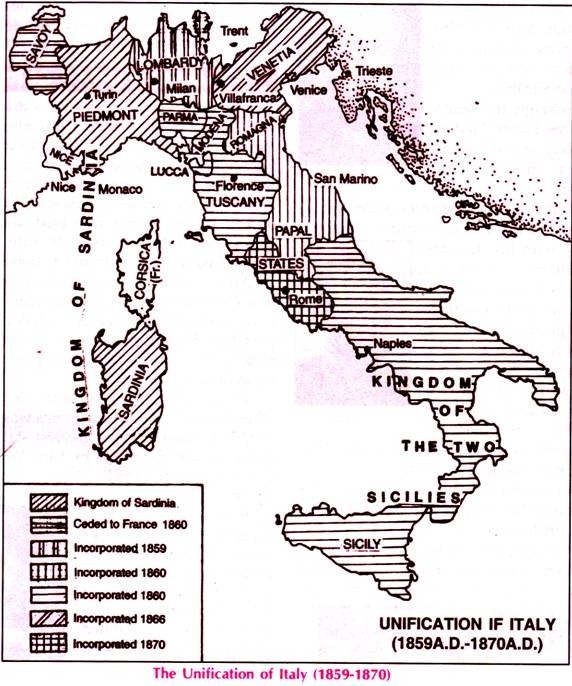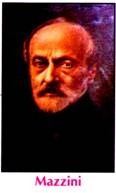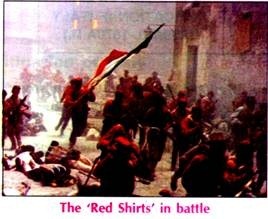The Growth of Nationalism in Europe!
A nation may be described as a community having a common homeland, a common culture and common traditions.
European nationalism, in its modern sense, was born out of the desire of a community to assert its unity and independence. In the 19th century there began a determined struggle to realise nationalist aspirations.
The French Revolution had inspired people all over Europe. It spread the ideas of liberty, equality and fraternity and generated the spirit of nationalism.
ADVERTISEMENTS:
Napoleon, though he established a monarchy in France, carried forward the revolutionary ideals of equality and nationalism.

Image Source: 435729.medialib.glogster.com/thumbnails/8307b8c2b541fba65a06ed0d7491602855246a7a2fd30a803425ed4072270ac2/european-nationalism-source.jpg
Napoleon’s empire gave to Europe a form of unity, even though it was imposed by him through conquests. A new concept emerged which bound people together with a sense of belonging and unity. Nations began to be formed by those who shared a common tradition and common territory.
Between 1830 and 1848, a number of revolutions broke out. Though most of them failed, a few of these revolutions succeeded. Belgium rose in revolt against the union with Holland and the consequent Dutch domination.
ADVERTISEMENTS:
In a conference held in London, the European powers declared that Belgium would be an independent country. In 1831 Belgium was created a separate kingdom with Leopold as the king.While Belgium was successful, the Polish revolt was crushed by Russia.
Greece was under Turkey. Towards the end of the 18th century the national consciousness of the Greeks was stimulated by an intellectual revival which recalled the glories of the ancient Hellas.
The struggle for independence began in 1821. By the Treaty of Adrianople (1829) Turkey recognised the independence of Greece. The republic that was set up in Greece was replaced by a monarchy in 1832. The independence of Greece was an incident of great significance. It provided the first example of the victory of nationalism since the downfall of Napoleon.
ADVERTISEMENTS:
The Austrian Empire was composed of a number of kingdoms inhabited by different races, speaking different languages and having different cultures. There were the Germans in Austria, the Czechs in Bohemia, the Magyars in Hungary, the Poles in Galicia, the Italians in Lombardy and Venice and the Slavs in south-east Austria. All these peoples had become conscious of their national unity and had developed national aspirations.
Revolts had broken out in France in 1830 and 1848. The Revolt of 1848 ushered in a period of widespread revolts throughout the Austrian Empire. The Magyars of Hungary and the Slavs of Bohemia clamoured for national autonomy and constitutional government.
Finally in 1867 Hungary was recognised as an independent kingdom. A nationalist movement had also started in Prague. There the Czechs rose in a nationalist revolt demanding self-government for their kingdom. Austrian Emperor was forced to recognise the Czech Government. Though temporarily successful, most of these movements within the Austrian Empire ultimately ended in disaster.
The Triumph of Nationalism in Europe:
Unification of Italy:
After the downfall of Napoleon in 1815, the Congress of Vienna met mainly to redistribute the territories occupied by the French. The makers of the Vienna Settlement tried to prevent the spread of the ideas of democracy and nationalism. Despite their efforts, liberal ideas were gaining ground.
Italy had been divided into small kingdoms and principalities. Napoleon, through his conquests, brought the country under a single administrative unit. The Italians imbibed the revolutionary ideals of liberty and nationalism and became conscious of the need for their own national integration.
The fall of Napoleon again led to the disintegration of Italy. Austria got back Lombardy and Venetia, the Pope controlled Rome and Central Italy, Naples and Sicily were restored to the Bourbon family, Modena, Parma and Tuscany became independent duchies and kingdoms of Sardinia-Piedmont, Genoa and Savoy came under King Victor Emmanuel II. Thus Italy was reduced to a mere “geographical expression”.
In Italy, already a movement was going on for liberating these countries and uniting them into one State. Giuseppe Mazzini, who organised the ‘Young Italy’ movement, roused the enthusiasm of the Italians and kept alive the flame of nationalism.
In 1848, as in other parts of Europe, a revolutionary uprising started in Italy. But the struggle ended in failure. After 1848, the Sardinian King’s able Prime Minister, Count di Cavour, took the initiative of uniting Italy under Victor Emmanuel II.
The failure of the movement of 1848 made it clear to Cavour that Italian unification could be accomplished only with the assistance of strong powers like Austria and France. Cavour secured the goodwill of France when the Sardinian army joined the Crimean War in support of France.
With the support of France (under Napoleon III), Cavour fought with Austria (1859). Austria was ousted from Lombardy which was annexed to Sardinia. At this stage, the central Italian states, Parma, Modena and Tuscany, joined Sardinia Piedmont under Victor Emmanuel.
Meanwhile, an uprising broke out in Naples and Sicily. The revolutionary leader, Giuseppe Garibaldi, with his thousand ‘Red Shirts’ (soldiers), marched to Naples and Sicily in support of the revolts there. The Kingdom of the two Sicilies was liberated in 1860. Naples and Sicily (known as the kingdom of the two Sicilies) joined Sardinia. Garibaldi was a republican, yet he supported, against his own conviction, the union of Italy under the crown.
Cavour dispatched an army to occupy the Pope’s principality which was conquered within a very short time. Thus by 1861, the whole of Italy, excepting Venetia and Rome, was united. Venetia was under Austria and Rome was ruled by the Pope.
Finally, Venetia was ceded to Italy by Austria in 1866 when Austria was weakened by the Prussian War. When Prussia attacked France in 1870, the Italian army occupied Rome. The unification of Italy was complete; Rome became the capital of united Italy.
The Unification of Germany:
Like Italy, Germany was also divided into small kingdoms. There were about three hundred small kingdoms and principalities in Germany. After conquering Germany, Napoleon Bonaparte had formed a confederation of the Rhine consisting of thirty nine states created out of the former three hundred states. The Germans, under Napoleon’s rule, became familiar with democratic and nationalist ideas.
After the downfall of Napoleon, these thirty nine German kingdoms were reorganised into a loose German Confederation with Austria as its president. Though Austria was a sworn enemy of democracy and liberalism, German nationalist aspirations did not die out.
The person responsible for the unification of all these small German kingdoms was Otto von Bismarck. Bismarck, the greatest statesman of all times, was appointed by King William I as the Chancellor (1862) (Prime Minister) of Prussia.
Bismarck devoted himself to the task of uniting the German states under Prussia. Already after the failure of the 1848 Revolution, Prussia had emerged as the undisputed leader of Germany. Bismarck believed that German unification could be achieved only through a policy of ‘blood and iron’, i.e. the use of military force. This was so because Austria, which was the President of the German confederation, would not easily give up her leadership of the confederarus, France was also hostile to the idea of a strong united Germany as her neighbour.
Bismarck achieved his aim of unifying Germany through three wars against Denmark, Austria and France. Bismarck first allied with Austria against Denmark. Defeated by the joint forces of Austria and Prussia, Danish king handed over Schleswig and Holstein to Prussia and Austria.
Austria and Prussia, however, fell out over their rights on the two provinces. In the war of 1866, Bismarck succeeded in defeating Austria. As a result Austria resigned from the German Confederation and her supremacy in North Germany was fully abolished. Prussia gained control over the North German states. The King of Prussia became the hereditary head of the north German states. Venetia was given to Italy.
The third war was fought against France in 1870-71. France was provoked to declare war against Prussia. When Napoleon III declared war on Prussia in 1870, the Southern German states joined the North in the Franco-German war. France was completely defeated in the war (Battle of Sedan). The German victory led to the political unification of Germany. The Prussian king, William I, was proclaimed Emperor of Germany. The spirit of nationalism brought about the unification of Germany. Within a short time a united Germany emerged as a powerful force in European polity.
